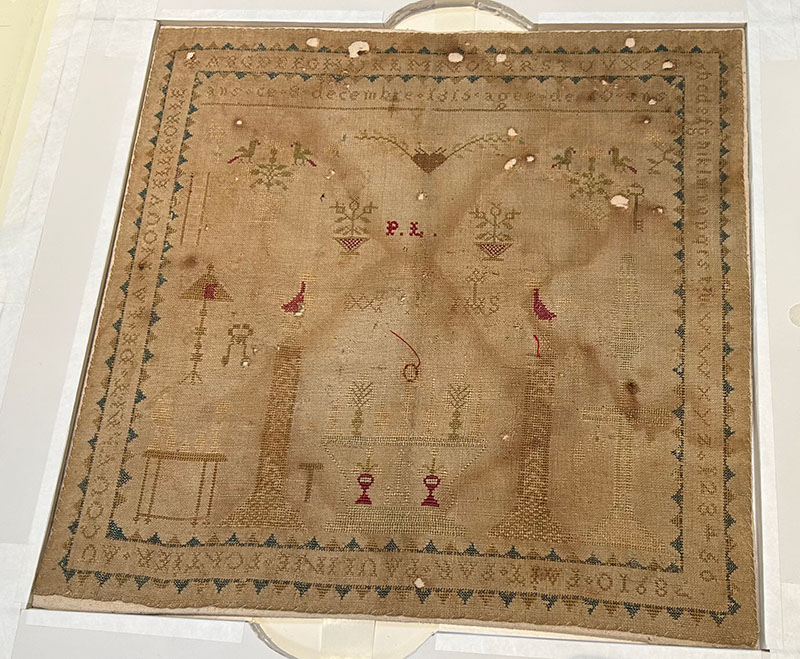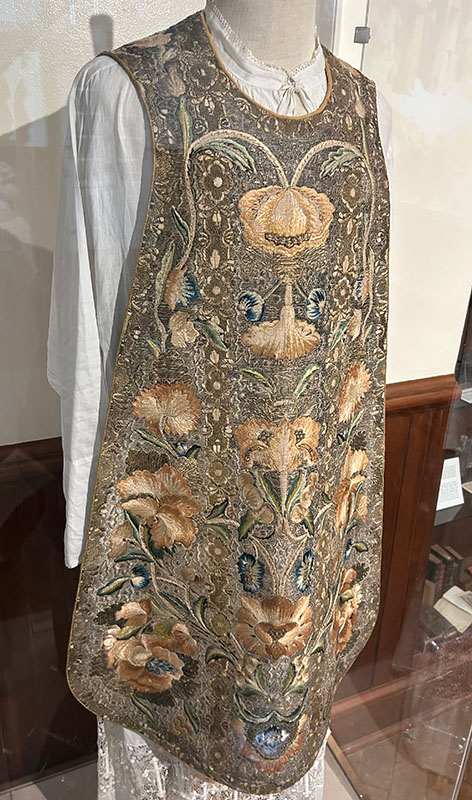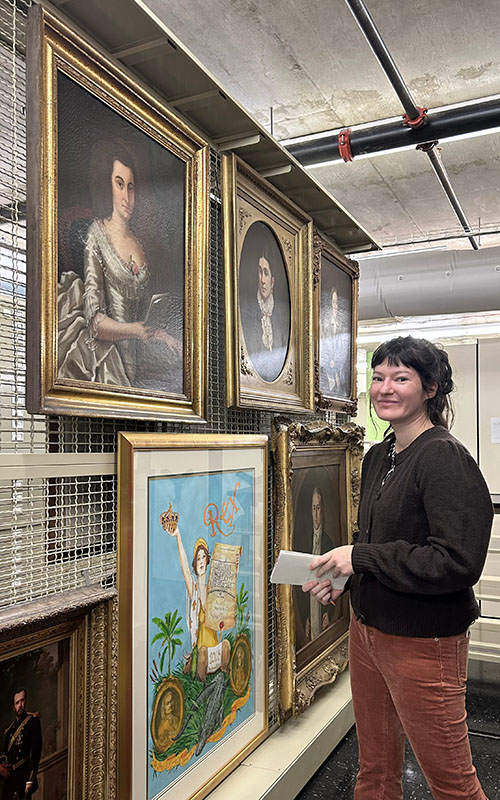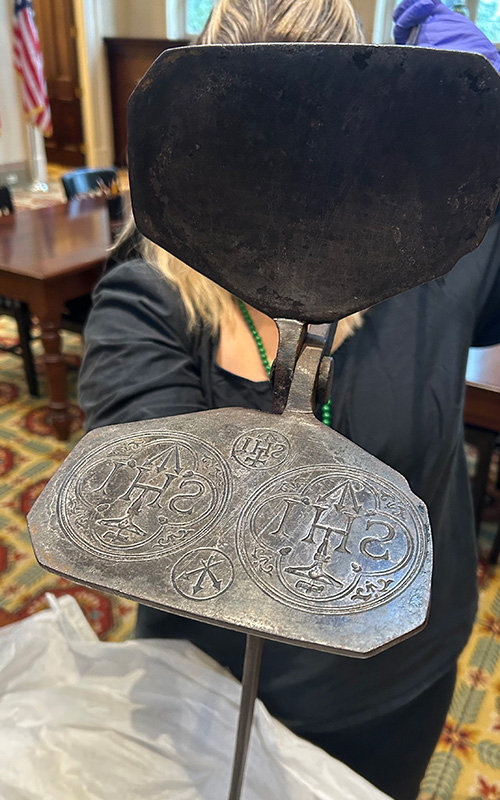Pauline Fortier’s Sampler: A Material Record of Early-19th-Century New Orleans
by Lily Higgins
My dissertation, “Reading into Things: Articulate Objects in Colonial North America,” investigates the ways in which self-referential inscriptions and visual imagery, applied to or embedded within an object’s surface, altered the ways in which everyday objects were used and understood. One chapter centers around a sampler (figure 1) from The Historic New Orleans Collection (HNOC), marked with an inscription that reads “fait par Pauline Fortier au Couvent de la Nouvelle Orleans ce Decembre 1815 agée de 10 ans.” With needle and thread, Pauline Fortier transformed a piece of plain linen into an articulate, speaking object.
The phrase “au Couvent de la Nouvelle Orleans” locates the sampler within the New Orleans geographical and cultural landscape, placing ten-year-old Pauline as a student at the Ursuline Convent school, where female literacy was prized. The convent still stands as testament to the important role the order played in shaping early New Orleans society, particularly through their mission to educate young women and mold them into exemplary Christian mothers. With the support of a Decorative Arts Trust Research Grant, I was delighted to visit the Ursuline Convent. Not only is the building where Pauline Fortier and her classmates would have studied a remarkable survival in and of itself, it also boasts a collection of treasures from the convent’s early history. An incredible 18th-century chasuble (figure 2), heavy with silk, gold, and silver embroidery, reflects the Ursuline legacy of fine textile production. The chasuble, consistent in quality and design to pieces made in France, could have been made in France or New Orleans. A similar example survives in the Ursuline convent in Quebec, along with an accompanying pattern, which proves that it was created in Quebec.
The Ursulines in New Orleans also maintained close ties to Europe through their library. The core collection of books that assisted the sisters in their mission to foster literacy and piety in Louisiana are now preserved at the HNOC. Although it was impossible to go through the entire catalog during my short visit, I sampled a few texts to explore the use of printed images within Catholic visual culture and pedagogy. Later I made my way to HNOC’s Royal Street Museum to examine a colorful manuscript songbook, heavily punctuated with vivid devotional imagery, which has a history of use in the Ursuline library beginning in 1754. The songbook reveals how objects played a crucial role in shaping devotional practices within the convent.
At the HNOC, I was fortunate to have the opportunity to carefully observe the Fortier sampler, to reconnect with Decorative Arts Curator Lydia Blackmore, and to meet Sarah Duggan, Decorative Arts of the Gulf South Project Manager. The Fortier sampler is the earliest surviving from Louisiana, and Lydia explained that the pattern of discoloration mimics the fold lines of the sampler, which was found stored in an armoire that descended in the Leon Sarpy family. This wear pattern highlights its value as a rare textile from the city’s early history. At the same time, the holes, fading, and stains make the sampler’s design difficult to fully parse without direct, in-person study. Looking closely with Lydia and Sarah, I was able to appreciate the symbolism of the arma christi (the Instruments of the Passion) imagery that Pauline Fortier so carefully rendered on the sampler’s surface.
Lydia graciously treated me to a behind-the-scenes tour highlighting the collection’s early portraits of women (figure 3) and a refectory table used in the Ursuline Convent. Conservative in form, but crafted from local materials like walnut and cypress, the table embodies the tension between tradition and adaptation that characterizes the Ursuline experience in early New Orleans. With Lydia and Sarah’s assistance (and gloves), I was able to handle an 18th-century wafer press (figure 4) from the convent and to fully imagine the physical strength and dexterity required to manipulate the heavy wrought iron instrument. The consumption of the Eucharist was vital to the Ursuline’s spiritual health, and objects like the iron played an integral intermediary role. The wafer iron facilitated the transformation of flour and water into a neatly stamped wafer, which a blessing would further transform into the sacred body of Christ. Like the needlework produced in the convent, the wafer iron embodies the connection between devotion and domestic labor.
Although marked with a clearly legible inscription that situates it in time and place, I believe that the sampler has nevertheless been slightly misinterpreted. In her informative report on Louisiana samplers, Lynn Anderson suggests that Pauline Fortier was the daughter of Louis Edmond Fortier (b. 1784) and Félicité LaBranche (b. 1785).¹ I had taken this information for granted until, while searching for newspaper advertisements that mentioned Pauline Fortier or Lestang Sarpy, whom she married in 1825, I found that Sarpy had placed an advertisement in The Courier in June of 1826. on behalf of his wife’s mother, described as the widow of Jacques Fortier. Sarpy’s ad documents the escape of an enslaved man named Chester, dressed in “striped velvet pantaloons and round-about of an olive color” from the Widow Fortier’s plantation, and specifies that Chester had been purchased from “Mr. Woolfolk” (most likely the infamous Baltimore slave trader Austin Woolfolk) only a few days earlier. While Louis Edmond Fortier and Félicité LaBranche did indeed marry in 1801, uniting the LaBranche and Fortier families, my own research, emanating from The Courier advertisement and confirmed by family genealogy, suggests that Pauline Fortier was the daughter of Jacques Fortier (b. 1759) and Aimee Marie Félicité Durel (b. 1768), who married in 1787.²
In the early 19th-century, Pauline Fortier and her family would have lived not at Louis Fortier and Felicité LaBranche’s Home Place, but across the river at Jacques Fortier and Aimée Durel’s St. Charles Parish sugar plantation. This seemingly slight change to the sampler’s origin story reorients us in an interesting way. On January 8, 1811, inspired by the success of the Haitian Revolution, hundreds of the enslaved men forced to labor on plantations along the Mississippi River organized an uprising. Seizing weapons and increasing in numbers as they made their way down river to New Orleans, the revolutionaries made it as far as Jacques Fortier’s plantation, where they were met by United States troops and militia. Although the Fortier’s plantation house no longer exists, I traveled to the neighboring Destrehan Plantation to experience the site’s interpretation of the 1811 German Coast Uprising. Many of the participants were tried, sentenced to death, and made into gruesome examples at Destrehan to discourage other enslaved people from rebelling against their oppressors. Additionally, traveling out of the city and into St. Charles Parish helped me to better understand the climate and natural landscape that informs Louisiana’s early architecture and has shaped the distinctive character of New Orleans.
In 1811, Pauline Fortier was probably still too young to be boarding at the convent school in the city, although her older sister Victorine (who later married unhappily into the Destrehan family) may have attended the school at that time. The 1811 Uprising was planned to coincide with the beginning of Carnival season, when most families would be gathered in New Orleans to celebrate the festivities.3 The Fortier family was likely among them. Whether or not she witnessed the violence firsthand, situating Pauline Fortier’s sampler within the aftermath of the 1811 uprising is a visceral reminder of the elite education she later received, and which resulted in the sampler, was made possible by the enslaved labor and sustained violence upon which her family’s wealth and status depended. When Pauline’s father died, his probate inventory, proved April 13, 1824, listed the names of nearly 80 enslaved people. The students who carefully cultivated literacy at the Ursuline convent school included not only the wealthy white daughters of plantation owners like Pauline Fortier but was open to young women of all races, means, and backgrounds. The newspaper advertisement placed by Lestang Sarpy in search of Chester clearly illustrates what was at stake in learning to read and write–in early Louisiana, literacy could be a tool of self-empowerment or of coercion and control.
The 1860 census records Pauline Fortier Sarpy living with her husband, whose occupation is given as a planter, and two of their adult children, Cydalise and Octave, in the sixth district of Saint Charles Parish. The census also records the 29 enslaved people, half men and half women and ranging in age from 1 to 60, who lived within six dwelling houses on the Sarpy estate. Ten years later, at 65 years old, Pauline was living alone in the 5th Ward of New Orleans. After LeStang Sarpy’s death in 1862, she applied to receive a pension for his participation in the War of 1812 and notably in the “siege or battles of New Orleans in December 1814 and January 1815.” The petition is a reminder that Pauline, who dated her sampler December 1815, was attending a traditional French convent school during a formative political moment in the city. The religious and practical education she received from the Ursulines fortified a distinctly French Catholic culture even as Louisiana became part of the United States. Pauline Fortier died in 1877, and Pauline and Lestang Sarpy now share a burial marker in Metairie Cemetery. The sampler, donated to the HNOC by descendants of the Sarpys, offers a distinctly personal insight into the history of early-19th-century New Orleans and its immediate surroundings.
- Anderson, Lynn. “Transnational Influences on Louisiana Samplers: Traditions, Teachers, Techniques, and Text.” (2016). Textile Society of America Symposium Proceedings.
- Cochran, Estelle M. Fortier. “The Fortier Family and Allied Families.” (1963).
- In her LSU master’s thesis, “La Madame et la Mademoiselle: Creole Louisiana, 1718-1865” Katy Frances Morlas, pulls from the Favrot family papers at the Howard Tilton Memorial Library to describe ten-year old Octavine Favrot’s 1810 admission to the Ursuline school in New Orleans and her mother’s careful plan to balance the festivities of the Carnival social season with the sacred contemplation required to take first communion. Students who traveled from distant rural areas to board in New Orleans could spend years away from their families, the Fortier family’s comparative proximity to the city (and their many social and kinship connections within it) probably made it possible for Pauline to return home more often.
Lily Higgins is a PhD candidate in the History of Art at Yale University.
About The Decorative Arts Trust Bulletin
Formerly known as the "blog,” the Bulletin features new research and scholarship, travelogues, book reviews, and museum and gallery exhibitions. The Bulletin complements The Magazine of the Decorative Arts Trust, our biannual members publication.
Click Images to Enlarge
Did you know that clicking on the images in Bulletin posts will allow you to get a closer look? Simply click on an image, and a larger version will open in a pop-up window.











